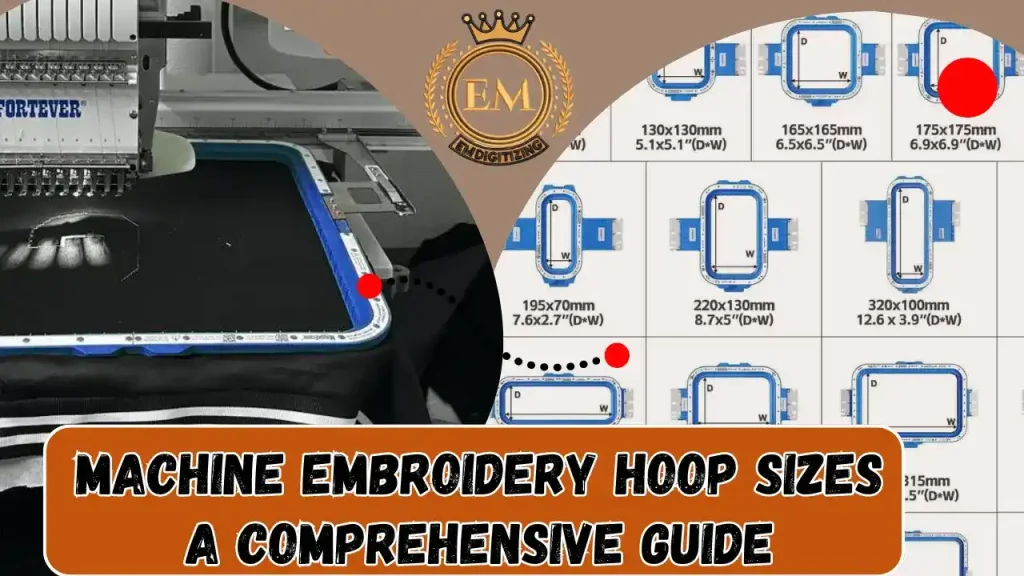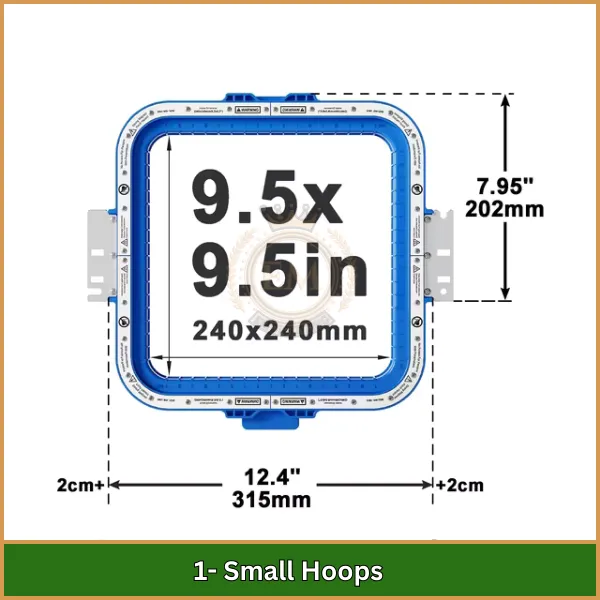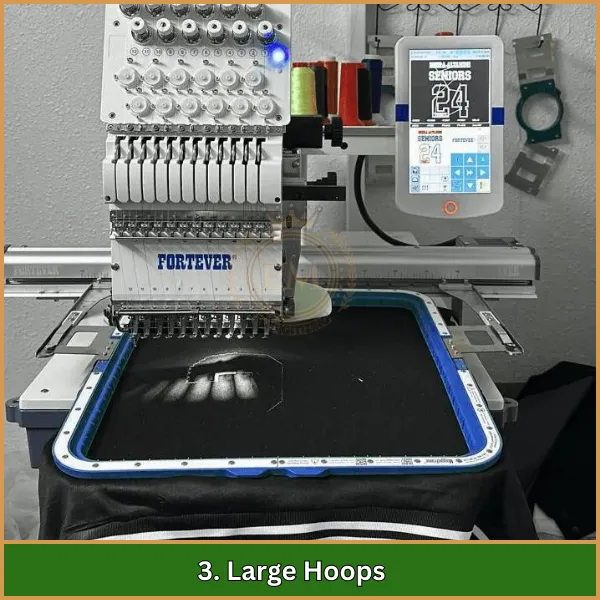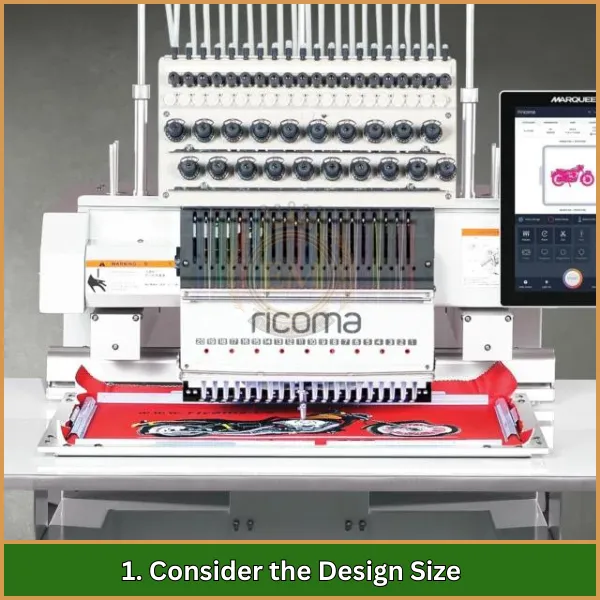Wenn es ums Sticken geht, Die Auswahl der richtigen Maschinenstickrahmengrößen ist einer der ersten Schritte, um ein schönes Design zu erzielen. Unterschiedliche Rahmengrößen können einen großen Einfluss darauf haben, wie gut Ihr Stoff an Ort und Stelle bleibt und wie präzise Ihre Nähte ausfallen.
Whether you’;Ich arbeite an einem winzigen, kompliziertes Design oder ein größeres Projekt, Es ist wichtig, die richtige Rahmengröße zu kennen.

In diesem Artikel, we’;Ich werde die verschiedenen Rahmengrößen aufschlüsseln, wofür sie am besten verwendet werden, und wie Sie das perfekte Modell für Ihr nächstes Projekt auswählen.
Lassen Sie uns gemeinsam den Prozess vereinfachen!
Größen der Maschinenstickrahmen: Ein umfassender Leitfaden
Stickrahmen verstehen
Ein Stickrahmen ist beim Maschinensticken von entscheidender Bedeutung, um den Stoff unter den starken Bewegungen der Stickmaschine stabil zu halten. Es besteht aus zwei Teilen: ein Innenring und ein Außenring. Der Stoff wird zwischen diese Ringe gelegt und gespannt, Bereitstellung einer glatten Oberfläche, auf der die Maschine sticken kann. Diese Anordnung trägt dazu bei, Faltenbildung im Stoff zu verhindern und stellt sicher, dass die Nadel an den richtigen Stellen durch den Stoff sticht, Dies ist für detaillierte und präzise Stickdesigns unerlässlich.
Bedeutung der Wahl der richtigen Rahmengröße
Die richtige Reifengröße ist mehr als nur eine Annehmlichkeit; es ist eine Voraussetzung für erfolgreiches Sticken. Ein entsprechend großer Rahmen hält Ihren Stoff sicher an Ort und Stelle, das erlauben Stickmaschine optimal zu leisten.
Umgekehrt, Schlecht gewählte Maschinenstickrahmengrößen können zu zahlreichen Problemen führen, wie zum Beispiel zu Stoffbewegungen während des Stickvorgangs, Dies kann zu falsch ausgerichteten Stichen und einem fehlerhaften Endprodukt führen.
Das Verständnis der Stickrahmendynamik hilft Stickern, diese Fallstricke zu vermeiden und einheitliche Ergebnisse zu erzielen, qualitativ hochwertige Ergebnisse.
Welche Größen der Maschinenstickrahmen sind verfügbar??
Stickrahmengrößen werden im Allgemeinen nach ihrem Durchmesser klassifiziert, die in Zoll angegeben wird. Zu den gängigsten Größen gehören:
- Kleine Reifen: Up to 4″;x4″;
- Mittlere Reifen: Sizes such as 5″;x7″; and 6″;x10″;
- Große Reifen: 8″;x8″;, 8″;x12″;, und größer
1. Kleine Reifen

Kleine Reifen sind kompakt Stickwerkzeuge, typically measuring 4″;x4″; oder kleiner. Diese Reifen sind ideal für detaillierte Arbeiten, kleine Projekte, bei denen Präzision entscheidend ist. Sie sind einfach zu handhaben und zu manövrieren, Damit eignen sie sich perfekt für komplizierte Designs auf kleineren Stoffstücken.
Anwendungen
Kleine Reifen eignen sich hervorragend für Projekte wie:
- Monogrammierung auf persönlichen Gegenständen wie Taschentüchern und Babykleidung.
- Detaillierte Stickerei auf kleinen Abschnitten eines Projekts, wie zum Beispiel ein Logo auf einer Tasche oder ein kleines Motiv auf einem Armband.
- Bastelprojekte, die feine Details erfordern, einschließlich der Herstellung von bestickten Miniaturkunstwerken für Schmuck oder Dekorationszwecke.
Vor-und Nachteile
Vorteile | Nachteile |
Einfach zu verwalten und ideal für Detailarbeiten | Beschränkt auf kleinere Designbereiche |
Leicht und tragbar | Kann bei längerem Gebrauch zu Ermüdung der Hände führen |
Im Vergleich zu größeren Reifen oft günstiger | Nicht für größere geeignet Stickprojekte |
2. Mittlere Reifen

Medium hoops typically range in sizes such as 5″;x7″; and 6″;x10″;. Diese Reifen bieten ein Gleichgewicht zwischen der Kompaktheit kleiner Reifen und der großen Fläche großer Reifen, Dadurch sind sie vielseitig für eine Vielzahl von Stickprojekten geeignet. Sie sind groß genug, um komplexere Designs aufzunehmen, aber dennoch handlich genug für eine einfache Handhabung.
Anwendungen
Mittelgroße Reifen sind dafür gut geeignet:
- Verschönern von Kleidungsstücken wie T-Shirts, Handtücher, und mittelgroße Dekorationsstücke.
- Erstellen Sie detaillierte Muster auf Wohnaccessoires wie Kissenbezügen oder Tischläufern.
- Abwicklung mittelgroßer Produktionsläufe für Kunden Stickereibetriebe, wo Vielseitigkeit in der Designgröße erforderlich ist.
Vor-und Nachteile
Vorteile | Nachteile |
Geeignet für eine Vielzahl von Stickprojekten | Möglicherweise nicht für sehr große oder sehr kleine Designs geeignet |
Bietet eine bessere Stoffspannung als kleinere Reifen | Schwerer und möglicherweise unhandlicher als kleine Reifen |
Ermöglicht detailliertere und größere Designs als kleine Reifen | Teurer als kleinere Reifen |
3. Große Reifen

Biggest embroidery machine hoop size typically includes sizes like 8″;x8″;, 8″;x12″;, und größer. Diese Rahmen sind unverzichtbar für umfangreiche Stickprojekte, die viel Platz benötigen. Sie eignen sich ideal für die Arbeit an großen Teilen wie Bannern, Steppdecken, und Vorhänge, Dies ermöglicht die Erstellung großformatiger Designs und Muster.
Anwendungen
Große Reifen sind perfekt für:
- Besticken großer Textilstücke, wie Steppdecken und Bettwäsche.
- Herstellung von Wandbehängen und anderen großen Dekorationsgegenständen.
- Verwaltung umfangreicher Stickprojekte, die von einem großen Stickbereich profitieren, Steigerung der Kreativität und des Designpotenzials.
Vor-und Nachteile
Vorteile | Nachteile |
Ermöglicht große Designs und komplizierte Muster | Kann schwer und unhandlich sein, speziell zum Handnähen |
Bietet bessere Sicht und Manövrierfähigkeit bei großen Projekten | Im Allgemeinen teurer als kleinere Reifen |
Geeignet für professionelle und großformatige Stickprojekte | Benötigt aufgrund ihrer Größe mehr Lagerraum |
Preisunterschiede bei Stickrahmengrößen für Stickmaschinen verstehen
Die Preise für Maschinenstickrahmengrößen können aufgrund verschiedener Faktoren, einschließlich der Größe, erheblich variieren, Material, Marke, und zusätzliche Funktionen. Hier finden Sie eine allgemeine Aufschlüsselung der Preisunterschiede zwischen verschiedenen Reifengrößen und -typen:
Kleine Reifen
- Kunststoffreifen: Die Preise liegen normalerweise zwischen $2 zu $10 jede. Dies sind die günstigsten Optionen, ideal für kleine, detaillierte Projekte.
- Holzreifen: Die Kosten liegen in der Regel zwischen $5 und $15, Bietet eine stabilere Konstruktion, die für eine bessere Spannung des Stoffes sorgen kann.
- Spezielle Formen und Merkmale: Kann reichen von $3 zu $12, Abhängig von der Komplexität und der spezifischen Verwendung des Reifens.
Mittlere Reifen
- Kunststoffreifen: Die Preise liegen in der Regel zwischen $5 und $15. Sie bieten eine gute Balance zwischen Erschwinglichkeit und Funktionalität für mittelgroße Projekte.
- Holzreifen: Kosten zwischen $10 und $25, bekannt für ihre Haltbarkeit und bessere Stoffunterstützung.
- Spezielle mittlere Reifen: Diese können preislich stark variieren, von ca $10 zu $30, Oftmals für bestimmte Anwendungen konzipiert oder mit einfach anpassbaren Funktionen erweitert.
Große Reifen
- Kunststoffreifen: Beginnen Sie normalerweise bei ca $15 und kann bis zu gehen $30, geeignet für größere Stickprojekte.
- Holzreifen: Die Preise reichen von $20 zu $50, Aufgrund ihrer robusten Konstruktion, die für umfangreiche Stickarbeiten erforderlich ist, werden sie bevorzugt.
- Große Spezialreifen: Kann ziemlich kostspielig sein, reicht von $25 zu $60 oder mehr, vor allem, wenn sie über Funktionen wie einen Reifenständer oder fortschrittliche Spannmechanismen verfügen.
Richtlinien zur Auswahl der richtigen Maschinenstickrahmengrößen
Um bei Ihren Stickprojekten qualitativ hochwertige Ergebnisse zu erzielen, ist die Wahl der richtigen Größe des Maschinenstickrahmens von entscheidender Bedeutung.
Hier sind einige Richtlinien, die Ihnen bei der Auswahl der am besten geeigneten Rahmengröße helfen sollen:
- Designgröße
- Stofftyp
- Projektanforderungen
- Komfort und Benutzerfreundlichkeit
- Maschinenkompatibilität
- Projektdauer und -häufigkeit
- Überlegungen zu zukünftigen Projekten
1. Berücksichtigen Sie die Designgröße

Die grosse von Stickerei-Design Das, was Sie nähen möchten, ist der kritischste Faktor. Wählen Sie immer einen Rahmen, der Ihr gesamtes Design bequem aufnehmen kann und an den Rändern etwas Spielraum hat.
Wenn der Reifen zu klein ist, Dies schränkt das Design ein und verursacht möglicherweise Probleme mit der Stoffspannung. Umgekehrt, Ein zu großer Rahmen kann dazu führen, dass sich der Stoff nur schwer stabilisieren lässt, Dies führt zu ungleichmäßigen Nähten.
2. Bewerten Sie den Stofftyp
Verschiedene Stoffarten haben unterschiedliche Handhabungseigenschaften:
- Dicke Stoffe B. Denim oder Polstermaterial, erfordern möglicherweise stabilere Reifen, um sie sicher zu halten.
- Zarte Stoffe wie Seide oder Chiffon müssen kleiner sein, Leichtere Reifen, um Stoffschäden durch übermäßige Spannung zu verhindern.
3. Verstehen Sie die Projektanforderungen

Berücksichtigen Sie die Gesamtanforderungen Ihres Projekts:
- Kleine Gegenstände wie Abzeichen oder Aufnäher eignen sich am besten für kleine Reifen.
- Mittelgroße Projekte B. Hemdlogos oder Handtuchdesigns, passen gut zu mittelgroßen Reifen.
- Große Projekte B. Tischdecken oder Quiltblöcke, benötigen große Rahmen, um die großen Stoffflächen effizient verarbeiten zu können.
4. Bewerten Sie Komfort und Benutzerfreundlichkeit
Besonders bei größeren oder komplexeren Projekten, Überlegen Sie, wie sich die Stickrahmengröße auf Ihren Komfort während des Stickvorgangs auswirkt:
- Größere Reifen kann schwer und unhandlich sein, Möglicherweise ist ein Ständer für Maschinenstickereien erforderlich.
- Kleinere Reifen sind leichter zu handhaben, können jedoch bei längerer Verwendung zu einer Ermüdung der Hände führen.
5. Überprüfen Sie die Maschinenkompatibilität
Stellen Sie sicher, dass der Stickrahmen mit Ihrer Stickmaschine kompatibel ist. Nicht alle Reifen passen auf alle Maschinen, Daher ist es wichtig, die Marke zu überprüfen, Modell, Größe und Größe des Stickrahmens sind für Ihre spezielle Stickmaschine geeignet.
6. Projektdauer und -häufigkeit
Wenn Sie häufig an ähnlichen Projekten arbeiten, Wählen Sie einen Reifen, der Flexibilität und Haltbarkeit bietet:
- Zum häufiger Gebrauch, Investieren Sie in hochwertige Reifen, die der Abnutzung standhalten.
- Zum gelegentlicher Gebrauch, Einfachere Modelle könnten ausreichen, provided they still meet your project’;s Bedürfnisse.
7. Überlegungen zu zukünftigen Projekten
Überlegen Sie, ob Sie in Zukunft auf größere oder vielfältigere Stickprojekte expandieren könnten. Wenn Sie von Anfang an in verschiedene Rahmengrößen investieren, können Sie Zeit sparen und sicherstellen, dass Sie immer auf jedes Projekt vorbereitet sind.
Endgültiges Urteil
Die Beherrschung der richtigen Maschinenstickrahmengrößen ist der Schlüssel zu makellosen Ergebnissen bei jedem Projekt. Der richtige Rahmen hilft, Ihren Stoff an Ort und Stelle zu halten, minimiert Fehler, und stellt sicher, dass jeder Stich perfekt platziert ist.
Mit diesem Wissen, Sie sind jetzt besser darauf vorbereitet, den idealen Rahmen für Ihre Designs auszuwählen.
Wenn es um die Digitalisierung Ihrer Stickmotive geht, EMdigitalisieren ist hier, um zu helfen. Wir sind stolz darauf, schnelle Bearbeitungszeiten zu bieten, erschwingliche Preise, und erstklassige Qualität. Und als Bonus, Wir bieten an 50% Rabatt für alle Erstkunden!
Lassen Sie uns Ihre Stickerei mit unserem Profi auf die nächste Stufe bringen Digitalisierung von Dienstleistungen.
Häufig gestellte Fragen
Für Anfänger, Die besten Reifen sind solche aus Bambus oder Kunststoff mit einer Einstellschraube aus Messing, Bietet Benutzerfreundlichkeit und Stabilität für verschiedene Projekte.
Zur Bestimmung der richtigen Stickrahmengröße, Wählen Sie eine Größe, die etwas größer ist als die Designfläche, um sicherzustellen, dass der Stoff straff bleibt und sich leicht verarbeiten lässt.
Die Größe der Reifen, die Sie benötigen, hängt von Ihrem Projekt ab; häufig, ein satz einschließlich kleine (4 Zoll), Mittel (6 Zoll), und groß (10 Zoll) Durchmesser deckt die meisten Projekte ab.
Um den richtigen Reifen auszuwählen, Betrachten Sie das Material (Bambus, Plastik, oder Metall für Haltbarkeit), die Größe im Verhältnis zu Ihrem Projekt, and the hoop’;s-Verschlusstyp zur Kontrolle der Stoffspannung.
